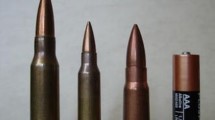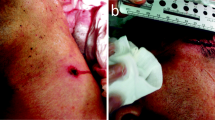“There seems to be a sort of mystery in the business of gun-shot wounds” John Bell
John Bell
Abstract
Understanding the mechanism of tissue damage by handgun and rifle ammunition involves a certain level of familiarity with the ballistic behaviour of bullets in soft targets. The damage produced may be limited to tissue disruption along the path of the penetrating projectile, which is the type of injury seen with non-deforming handgun bullets and under favourable conditions with military rifle bullets, or extended to affect the tissues surrounding the wound track. The latter pattern of injury involves significantly higher amounts of energy spent in the form of tissue displacement after the passage of the bullet, in addition to the energy normally required for simple tissue penetration. Bullet tumbling along longer wound tracks is the main mechanism of such high-energy trauma by non-deforming rifle bullets. However, when bullet construction allows deformation upon impact, the resultant injury is directly proportional to the impact velocity of the projectile. The momentum imparted to the tissue by the penetrating projectile results in a highly dynamic phenomenon of radial displacement of tissue in its wake causing the formation of a temporary cavity. Depending on the tissue tolerance to the associated tensile strain, extensive soft tissue damage may be encountered. Devitalized tissue may not be obvious during initial exploration, thus necessitating an expectant policy involving wound revision over a period of days.
Similar content being viewed by others
References
Baroni S, Richmond TS. Firearm violence in America: a growing health problem. Crit Care Nurs Clin North Am 2006;18:297–303.
Zarocostas J. Proliferation of firearms is growing global health problem. BMJ 2007;335:470.
Small Arms Survey 2007: guns and the city. Chapter 2, annexe 4. http://www.smallarmssurvey.org/publications/by-type/yearbook/ small-arms-survey-2007.html. Accessed 1 Apr 2015.
O’Kelly F, Gallagher TK, Lim KT, Smyth PJ, Keeling PN. Gun Shot-101: an 8-year review of gunshot injuries in an Irish teaching hospital from a general surgical perspective. Ir J Med Sci 2010;179:239–43.
Papadopoulos IN, Kanakaris NK, Danias N, et al. A structured autopsy-based audit of 370 firearm fatalities: Contribution to inform policy decisions and the probability of the injured arriving alive at a hospital and receiving definitive care. Accid Anal Prev 2013;50:667–77.
Lindsey D. The idolatry of velocity, or lies, damn lies, and ballistics. J Trauma 1980;20:1068–9.
Hutton JE, Rich NM. Wounding and wound ballistics. In: McAninch JW, editor. Traumatic and reconstructive urology. Philadelphia: Saunders; 1996. pp. 3–25.
Mayberry JC, Trunkey DD. Wound ballistics: what every trauma surgeon should know. In: Asensio JA, Trunkey DD, editors. Current therapy of trauma and surgical critical care. Philadelphia: Mosby; 2008. pp. 82–7.
Kneubuehl BP, Coupland RM, Rothschild MA, Thali MJ. Wundballistik: Grundlagen und Anwendungen. 3rd ed. Heidelberg: Springer; 2008.
Quick J. Dictionary of weapons and military terms. New York: McGraw-Hill; 1973. p. 84.
Hollerman JJ, Fackler ML, Coldwell DM, Ben-Menachem Y. Gunshot wounds: 1. Bullets, ballistics, and mechanisms of injury. AJR Am J Roentgenol 1990;155:685–90.
Hopkinson DAW, Marshall TK. Firearm injuries. Br J Surg 1967;54:344–53.
Gyftocostas D, Komborozos B. The mechanism of firearm injury. Iatrika Chronika 1986;9:17–26.
Mendelson JA. The relationship between mechanisms of wounding and principles of treatment of missile wounds. J Trauma 1991;31:1181–202.
Janzon B. Projectile–material interactions: simulants. In: Cooper GJ, Dudley HA, Gann DS, Little RA, Maynard RL, editors. Scientific foundations of trauma. Oxford: Butterworth-Heinemann; 1997. pp. 26–36.
Bluman EM, Ficke JR, Covey DC. War wounds of the foot and ankle: causes, characteristics, and initial management. Foot Ankle Clin North Am 2010;15:1–21.
Bellamy RF, Zajtchuk R. Conventional warfare: ballistic, blast, and burn injuries. Washington DC: Walter Reed Army Medical Center, Office of the Surgeon General; 1991.
Fackler ML. Gunshot wound review. Ann Emerg Med 1996;28:194–203.
McSwain NE, Ballistics. In: Ivatury RR, Cayten CG, editors. The textbook of penetrating trauma. Baltimore: Williams & Wilkins; 1996. pp. 105–19.
Fackler ML, Dougherty PJ. Theodor Kocher and the scientific foundation of wound ballistics. Surg Gynecol Obstet 1991;172:153–60.
Jenkins DH. The effects of bullets. In: Brooks AJ, Clasper J, Midwinter MJ, Hodgetts TJ, Mahoney PF, editors. Ryan’s ballistic trauma: a practical guide. 3rd ed. London: Springer; 2011. pp. 37.
Harvey EN, Korr IM, Oster G, McMillen JH. Secondary damage in wounding due to pressure changes accompanying the passage of high velocity missiles. Surgery 1947;21:218–39.
Bellamy RF. The medical effects of conventional weapons. World J Surg 1992;16:888–92.
Peters CE, Sebourn CL. Wound ballistics of unstable projectiles. Part II: temporary cavity formation and tissue damage. J Trauma 1996;40(Suppl 3):S16–S21.
Dougherty PJ, Fackler ML. Wound ballistics: the pathophysiology of wounding. In: Dougherty PJ, editor. Gunshot wounds. Rosemont, IL: American Academy of Orthopaedic Surgeons; 2011. pp. 11–8.
Breeze J, Sedman AJ, James GR, Newbery TW, Hepper AE. Determining the wounding effects of ballistic projectiles to inform future injury models: a systematic review. J R Army Med Corps 2014;160:273–8.
Karger B. Forensic ballistics. In: Tsokos M, editor. Forensic pathology reviews, volume 5. Totowa, NJ: Humana; 2008. pp. 139–72.
Fackler ML, Bellamy RF, Malinowski JA. The wound profile: illustration of the missile-tissue interaction. J Trauma 1988;28(Suppl 1):S21–9.
Boylan M. Trauma: ballistic and blast. In: Nutbeam T, Boylan M, editors. ABC of prehospital emergency medicine. Oxford: Wiley-Blackwell; 2013. pp. 103–9.
Harvey EN, McMillen JH, Butler EG, Puckett WO. Mechanism of wounding. In: Beyer JC, editor. Wound ballistics. Washington, DC: Office of the Surgeon General; 1962. pp. 143–235.
Janzon B. High energy missile trauma: a study of the mechanisms of wounding of muscle tissue. (Doctorial thesis). Gothenburg, Sweden: Faculty of Medicine, University of Göteborg; 1983.
Felsmann MZ, Szarek J, Felsmann M, Babinska I. Factors affecting temporary cavity generation during gunshot wound formation in animals–new aspects in the light of flow mechanics: a review. Veterinarni Medicina 2012;57:569–74.
Dana SE, Di Maio VJM. Handbook of forensic pathology. Boca Raton, FL: CRC Press; 2006. pp. 131.
Fackler ML. Wound ballistics: a review of common misconceptions. JAMA 1988;259:2730–6.
Janzon B, Hull JB, Ryan JM. Projectile-material interactions: soft tissue and bone. In: Cooper GJ, Dudley HA, Gann DS, Little RA, Maynard RL, editors. Scientific foundations of trauma. Oxford: Butterworth-Heinemann; 1997. pp. 37–52.
Cooper GJ, Ryan JM. Interaction of penetrating missiles with tissues: some common misapprehensions and implications for wound management. Br J Surg 1990;70:606–10.
Fackler ML, Surinchak JS, Malinowski JA, Bowen RE. Bullet fragmentation: a major cause of tissue disruption. J Trauma 1984;24:35–9.
Fackler ML. Ballistic injury. Ann Emerg Med 1986;15:1451–5.
Bolliger SA, Thali MJ, Bolliger MJ, Kneubuehl BP. Gunshot energy transfer profile in ballistic gelatin, determined with computed tomography using the total crack length method. Int J Legal Med 2010;124:613–6.
Jussila J, Kjellström BT, Leppäniemi A. Ballistic variables and tissue devitalisation in penetrating injury-establishing relationship through meta-analysis of a number of pig tests. Injury 2005;36:282–92.
Russell R, Clasper J, Jenner B, Hodgetts TJ, Mahoney PF. Ballistic injury. In: Skinner DV, Driscoll PA, editors. ABC of major trauma. 4th ed. Oxford: Wiley-Blackwell; 2013. pp. 171–9.
Fackler ML, Breteau JP, Courbil LJ, Taxit R, Glas J, Flevet JP. Open wound drainage versus wound excision in treating the modern assault rifle wound. Surgery 1989;105:576–84.
Giannou C, Baldan M. War surgery: working with limited resources in armed conflict and other situations of violence. Vol. 1. Geneva: ICRC; 2009. pp. 83–91.
Coupland RM. The Red Cross classification of war wounds: the E.X.C.F.V.M. scoring system. World J Surg 1992;16:910–7.
Brooks A, Barker P. Missile and explosive wounds. Surgery (Oxford) 2003;21:190–2.
Robertson BC, Manson PN. High-energy ballistic and avulsive injuries. Surg Clin North Am 1999;79:1489–502.
Saadia R, Schein M. Débridement of gunshot wounds: semantics and surgery. World J Surg 2000;24:1146–9.
Author information
Authors and Affiliations
Corresponding author
Additional information
“Discourses on the nature and cure of wounds” (1795)
Rights and permissions
About this article
Cite this article
Stefanopoulos, P.K., Pinialidis, D.E., Hadjigeorgiou, G.F. et al. Wound ballistics of gunshot injuries. Hellenic J Surg 87, 351–356 (2015). https://doi.org/10.1007/s13126-015-0240-3
Received:
Accepted:
Published:
Issue Date:
DOI: https://doi.org/10.1007/s13126-015-0240-3




